Voici comment réaliser un piemontais avec manche en corne. Pour la réalisation de la lame, je vous laisse vous reporter à l'autre tutorial sur la réalisation d'un piemontais.
How to make a friction folder with horn handle. For the blade making you can see the process on my other friction folder how to.
Matériel nécessaire
1 lame prévue pour un piemontais.
1 corne Ici du zebu
1 dremel avec un disque à tronçonner, feutre de polissage, gomme à polir.
1 rivet, 2 ou 4 rondelles de laitons (2 rondelles de friction en lame de rasoir si besoin)
1 disque abrasif sur ponceuse en grain 36, un abrasif en grain 80, grains 120 , 150, 240. Feutre de polissage et pate à polir.
1 étau, un marteau à riveter.
Material
1 friction folder blade, one horn (here a zebu horn)
1 dremel with cutting disk, polishing wheel and polishing rubber.
1 pin, 2 brass washer, (eventually two rasor blade friction washer)
1 sand adaptator for drill machine (or one beltsander) grit, 36, 80,120,150,240 and felter with polish paste.
1 hammer
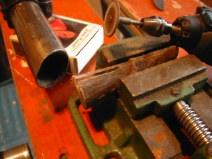
Prenez une corne à peu prés de la taille de votre lame histoire de ne pas avoir trop à retoucher. La première étape est de creuser le canal. Avec un disque à tronçonner (le plus neuf que vous avez comme ça le diamètre sera le plus important possible), creuser le canal à vitesse réduite (attention cela chauffe et sent particulièrement mauvais) Le disque fait 2 mm d'épaisseur et ma lame 4 donc je procéde en passes successives jusqu'à ce que j'arrive à avoir un canal d'a peu prés 4 mm de largeur et pas trop profonc pour commencer.
Choose one horn with a size proach of your blade. You won't have too material to put away. The first step is to cut the channel. With the dremel cutting disk (with the higher diameter you have), cut the chanel with a low speed (the horn is fast to be heat, and the dust smell not good at all). The disk is 2 mm thick, and the blade 4 mm, i cut with successive passage. mm after mm in order to obtain a 4 mm chanel. Don't cut too deeply for beguinning, it's impossible to ad material but easy to put away some more :).
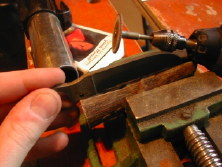
The blade has the good size for the horn. La lame à la bonne taille pour la corne.

The channel is totaly cut. Le canal est entièrement creusé.
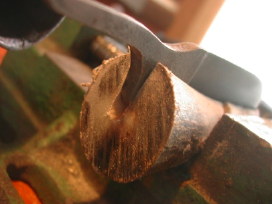
Une idée de la profondeur. An idea of the cut deep.
After you will adjust in function of the blade and the thickness of your horn
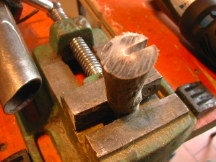
Une fois le canal principal de réalisé, ou va couper la corne en deux sur son début histoire de laisser pivoter la lame.
One time the chanel is finished, man can cut the horn in two part on his beguinning in order to permit to the blade to pivot.

La corne est coupée sur a peu prés 1,5 cm de profondeur, on ajuste en faisant pivoter la lame.
The horn is cut on almost 1,5 cm deep, it's adjusted with pivoting the blade.
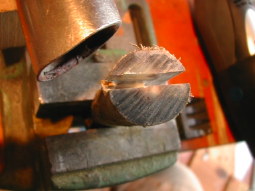
La corne est coupée sur sont début. The cut is it
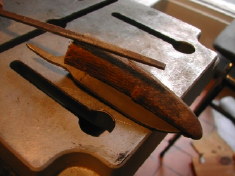
La lame dans son emplacement en position fermée. On peut ajuster la profondeur en fonction de la hauteur de la corne et de celle de la lame. Avec une lime triangulaire, marquez sur la corne le point le plus bas du talon de la lame une fois en position. tout en conservant à l'idée que la lame doit pouvoir pivoter.
The blade in her place in closed position. You can adjust the deep function to the horn and blade size.With a triangular file, mark the lowest point of the blade heel when the blade is in the channel. You must keep in mind that the blade have to pivot.

Sortez la lame de son canal et placez là sur la corne comme si elle était encore dans le canal. servez vous de la marque faite à la lime pour reperer le point le plus bas du talon. Ensuite marqué le centre du trou sur la crone à l'aide d'une pointe ou à l'aide d'un feutre.
Put the blade on the horn at the same position to simulate the place in the chanel, you have to use the file mark on horn to position the heel of the blade. Mark the center of the hole with a point of a pen.
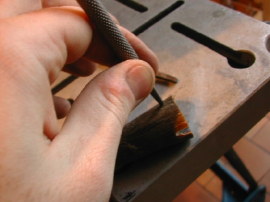
A l'aide d'une pointe ou d'un pointeau renforcé l'emplacement à percer. With a point mark the spot to drill.
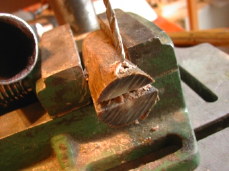
Mettez la corne dans l'étau et percez lentement à l'aide d'un forêt de la taille du trou de votre lame à l'emplacement que vous venez d'indiquer
Fix the horn and drill with a drill bit of the same size than the blade hole, on the point you have just to mark.
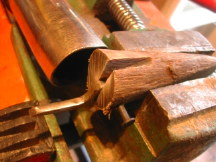
On peut faire un premier assemblage.
Try to assembly the piece together with the pin.

Faite pivoter la lame jusqu'à ce quelle rencontre de la corne. Là on voit qu'il faut retoucher le canal supérieur. Retouchez le à l'aide du disque à tronçonner ou à la lime jusqu'à ce que la lentille s'intégre à votre guise dans le manche. Vous pouvez désirer ne pas avoir la lame totalement dans l'axe du manche, aprés c'est à vous de voir.
Pivot the blade in order to see the maximum of movement possible. You can see you have to put away some material in the top chanel. Re cut with the cutting disk or a file. The main aim is that the queue of the blade find totaly her place in the horn.
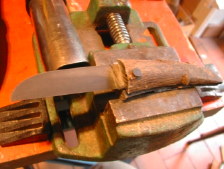
Quand la lame se positionne correctement, cela peut donner quelque chose comme ça.
When the blade has a good position, it could be something like that.
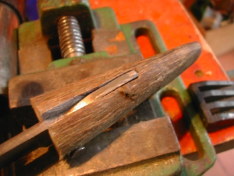
La lentille s'intègre dans la corne.
The blade queue find her place in the horn.
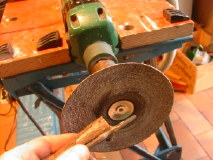
With the sander Disk mount on drill machine (grit 36 but you can use a simple belt sander with the same grit )to remplace that step, i use that tool because when i make the picture i have no more grit 36 for my little belt sander :)).You have to thin the handle. You have to put away some material in order to round all the part of the horn. Try to obtain a simetrical thichness. (it's not alway easy because horn was something alive and not formated at all)
Avec un disque abrasif grains 36 monté sur une perceuse (on peut remplacer par le même grain sur une ponceuse à bande, mais dans le cas présent je n'en avais plus sous la main). Vous devez affiner le manche. Vous enleverez la matière de manière à obtenir quelque chose le plus symétrique possible au niveau de l'épaisseur de chaque coté du canal. (ce n'est pas toujours facile compte tenu du fait que la corne est un matériaux vivant et pas formaté à la base)
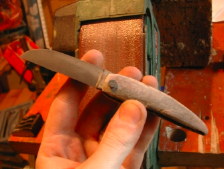
Voila un peu ce que cela donne. Ensuite ponçage au grain 80 histoire de continuer l'affinage.J'utilise ma ponceuse à bande et je me sers principalement de la petite roue de contact et de la petite partie de bande libre pour arrondir l'ensemble.
The result after the 36 grit, after sand with 80 grit in order to thin more the handle. I use my belt sander and mainly the" mini contact wheel" and the free band to rounded all the surface.
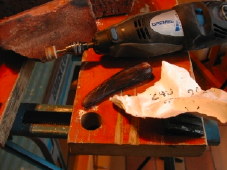
Aprés un passage au grain 120 et 150 sur la ponceuse, je fini à la main au 240 et plus si affinité. Puis polissage à la dremel et pate à polir rekor sur feutre mais à vitesse trés réduite et avec des mouvements continue . Si vous restez au même endroit ne serais que deux seconde la corne va se teinter différement et il faudra reponcer et repolir.
After to grinded with 120 and 150 grit on the belt sanded. Finish with hand 240 or more grit grind .After polish with dremel felter and polish paste, try to make continu movement and don't stay to the same point during more than 1 seconde, because if you stay too long time on the same point the horn with take another color on that point and you will have to sand another time and repolish to obtain the same result everywhere.

Le couteau prémonté sur la plaque qui me sers à riveter et avec lepetit marteau boule pour riveter.Le rivet a été coupé à 4 mm de plus que l'épaisseur de la corne et des deux rondelles de laiton. (Deux rondelles de frictions se trouve à l'intérieur du manche et sont réalisées à partir de lame de rasoir, mais ceci fait l'office d'une autre tuto par Rems sur france Balisong et par Chris Crawford sur son site). Mettez une rondelle de chaque coté et laissez dépasser 2 mm de rivet. martelez le premier coté toujours à 45° (les coups sont portés avec un angle de 45° de façon à ne pas écraser le pivot et le déformet, mais de façon à "pousser" la matiére vers les cotés)Faite la même chose de l'autre coté, et ainsi de suite jusqu'a ce que le rivet fasse bien son office que la friction soit suffisante sans bloquer le movuement de la lame.
The knife is assembly, you can see the steel plate and the round hammer i use to pin the pin. Cut the pin to 4 mm more than the thickness of the horn + the thickness of the two brass wascher.Put one wascher on each side of the horn and pin it with the hammer in taking care to hit to 45° the pin in order to chase the material on the border and don't deform block the pivot.The aim is to make a muschroom with the head of the pivot and to recover all the center of the brass wascher. You continue to pin one side after the other during the time necessary to obtain a good friction, but don't block the pivot.
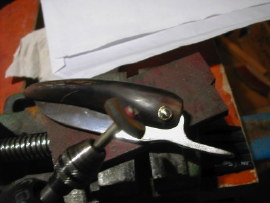
Aprés vous pouvez arrondir les angles de la rondelle à l'aide de la gomme à polir. Et nettoyer et polir le tout à l'aide du feutre à polir ainsi que de la pate à polir.
After you can rounded the wascher with a polishing rubber, and clean and polish the wascher and pivot pin with felter and polish paste.

The last step is the sharpen the knife :).
Il ne reste plus qu'a aiguiser et affuter :).